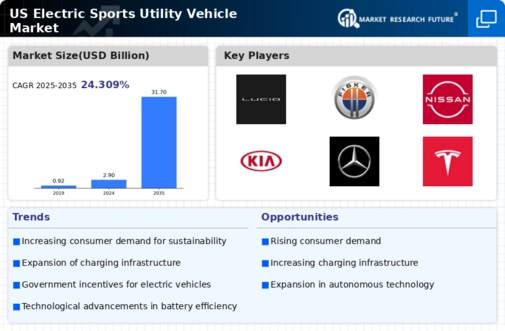The electric sports utility vehicle market is currently characterized by intense competition and rapid innovation, driven by a growing consumer preference for sustainable transportation solutions. Key players such as Tesla (US), Ford (US), and Rivian (US) are at the forefront, each adopting distinct strategies to enhance their market positioning. Tesla (US) continues to lead with its focus on cutting-edge technology and extensive charging infrastructure, while Ford (US) emphasizes its legacy in the automotive sector by integrating electric models into its existing lineup. Rivian (US), a newer entrant, leverages its unique positioning as an adventure-oriented brand, appealing to a niche market of outdoor enthusiasts. Collectively, these strategies contribute to a dynamic competitive environment, where innovation and brand loyalty play crucial roles.
In terms of business tactics, companies are increasingly localizing manufacturing to mitigate supply chain disruptions and enhance responsiveness to market demands. The competitive structure of the market appears moderately fragmented, with several players vying for market share. However, the influence of major companies like Tesla (US) and Ford (US) remains substantial, shaping industry standards and consumer expectations.
In November 2025, Ford (US) announced a strategic partnership with a leading battery technology firm to enhance its electric vehicle (EV) production capabilities. This collaboration is expected to streamline the supply chain and reduce production costs, thereby allowing Ford (US) to offer more competitive pricing on its electric sports utility vehicles. Such moves indicate a proactive approach to addressing the challenges of battery supply and technology integration.
In October 2025, Rivian (US) unveiled its latest model, the R1S, which features advanced autonomous driving capabilities. This launch not only showcases Rivian's commitment to innovation but also positions the company as a serious contender in the electric sports utility vehicle segment. The emphasis on autonomous technology may attract tech-savvy consumers, further differentiating Rivian (US) from traditional automakers.
In September 2025, Tesla (US) expanded its Gigafactory operations in Texas, significantly increasing its production capacity for electric sports utility vehicles. This expansion is pivotal, as it aligns with Tesla's strategy to meet the surging demand for EVs in the US market. The enhanced production capabilities are likely to solidify Tesla's market leadership and reinforce its commitment to sustainability through increased output of zero-emission vehicles.
As of December 2025, the competitive landscape is increasingly defined by trends such as digitalization, sustainability, and the integration of artificial intelligence in vehicle design and manufacturing. Strategic alliances are becoming more prevalent, as companies recognize the need for collaboration to enhance technological capabilities and market reach. Looking ahead, competitive differentiation is expected to evolve, with a shift from price-based competition to a focus on innovation, technology, and supply chain reliability. This transition underscores the importance of adaptability and forward-thinking strategies in navigating the complexities of the electric sports utility vehicle market.


























Leave a Comment